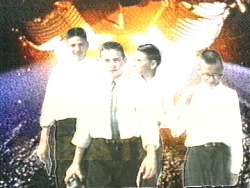Daniel Reeves
Biography
From impassioned indictments of America's culture of violence to soulful lamentations of spiritual loss, Daniel Reeves' body of work constitutes an important elaboration of video poetics. Reeves began working in video in 1979. Combat experiences in Vietnam were the driving force behind his early videotapes, which developed from preparatory work in sculpture, photography and film, and culminated in a classic work, Smothering Dreams (1981), which won three Emmy awards.
Subsequent tapes refined this work's use of poetic text and structure, addressing inhumanity, dispossession and social upheaval with a highly lyrical sensibility, and from an outlook informed by Eastern philosophy. These later works owe much to extensive travels throughout Asia. In outlining Reeves' video poetics, Amida (1983) and A Mosaic for the Kali Yuga (1986) can be seen as forming bookends in the exploration of formal strategies, arriving at their epilogue texts through elegantly precise visualizations that echo the illuminations and exigencies of the world views being addressed. Amida's observations are entirely concrete, while Mosaic's media-weaving employs sophisticated image-processing technology.
Since 1988 Reeves has been focusing on sculpture projects, digital prints, and video installations.
The videotapes Ganapati/A Spirit in the Bush (1986) and Sombra a Sombra (1988), along with Sabda (1984), occupy the central ground in Reeves' body of work, transforming different locations by adopting the visions of various source texts by poets like Garcia Lorca, Cesar Villejo and Kabir. In this way, Reeves helps us to see according to what we hear, creating elegant realizations and rhythms that inspirit the contemplations of this companion poetry.
Reeves was born in 1948 in Washington, D.C. He received a B.A. and an A.S. from Ithaca College. Among his numerous grants are six awards from the National Endowment for the Arts, three awards from the New York State Council on the Arts, and a John S. Guggenheim Memorial Foundation Fellowship. In 1988, he received a United States/Japan Exchange Fellowship. Reeves has served as artist-in-residence at the Television Laboratory at WNET/Thirteen, New York, and the Experimental Television Center, Owego, New York, among other institutions. His videotapes have been broadcast widely and exhibited internationally, at festivals and institutions including the Tokyo Video Festival, Japan; San Sebastian Video Festival, Spain; American Film Institute National Video Festival, Los Angeles; Documenta 7, Kassel, Germany; Edinburgh International Film Festival, Scotland; the Locarno Film Festival, Switzerland; Institute of Contemporary Art, Boston; Whitney Museum of American Art Biennial, New York; Musee du Louvre, Paris; The Tate Gallery, London; and The High Museum of Art, Atlanta. He is currently a research fellow in Visual Communications at the Edinburgh College of Art.
Reeves lives in Scotland and France.
